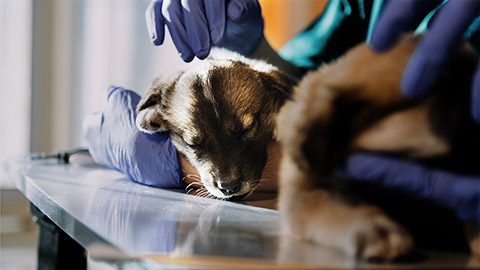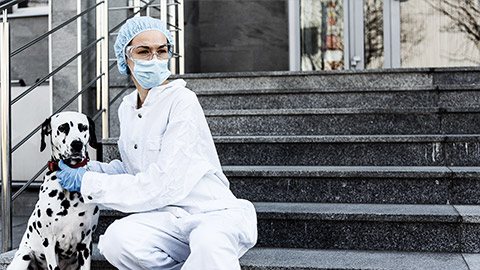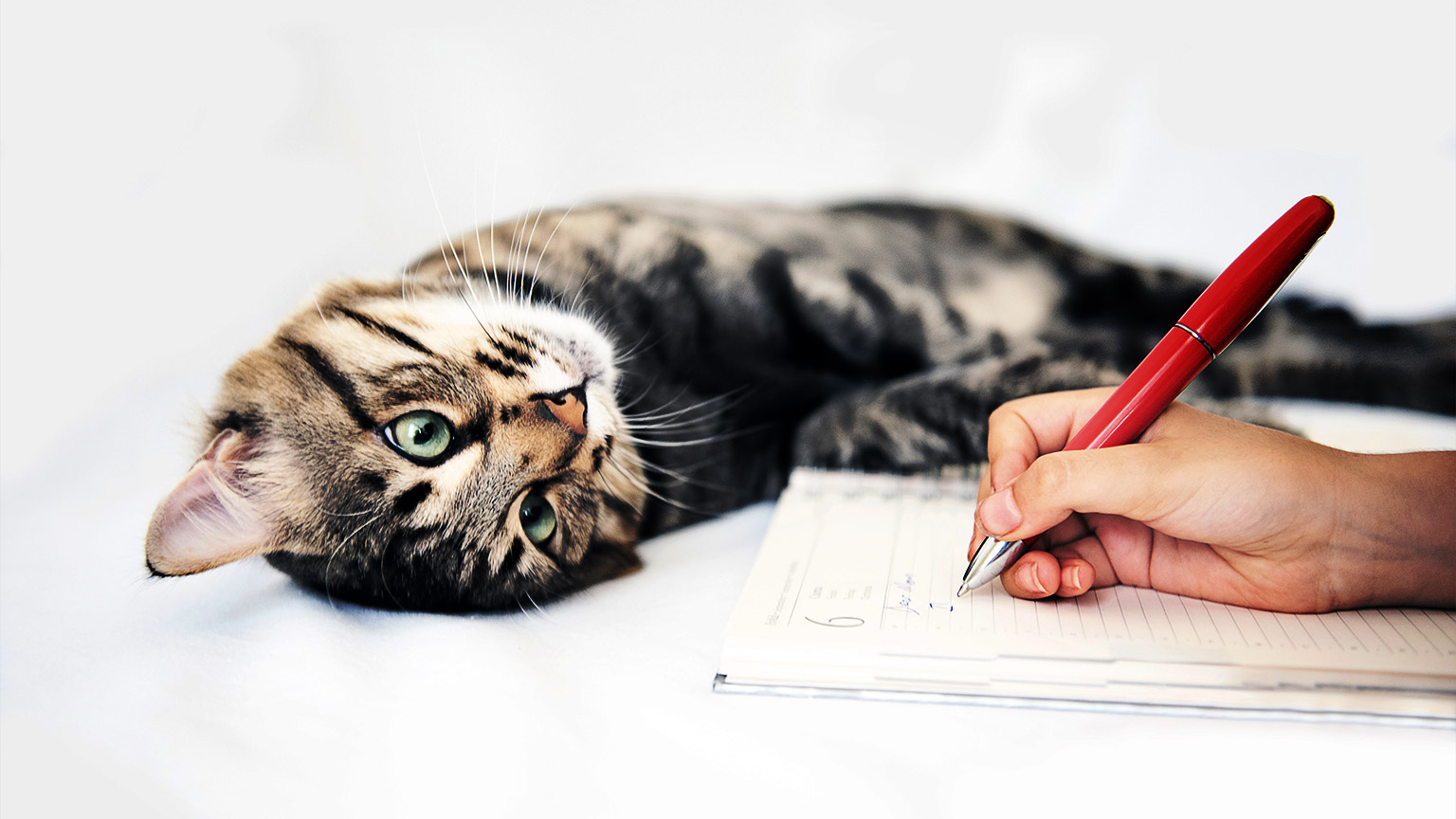Before proceeding with any procedure or treatment for an animal, there are three key steps you should follow:
- Identify the animal to be treated
- Identify the health care task for and welfare needs of that animal
- Confirm the animal and health care requirements with your supervisor.
Identify the animal to be treated
To ensure they receive the appropriate treatment, you need to identify the animal before you proceed with any procedure or treatment. Methods of identifying animals include:
- Confirming the identification of the animal with their owner
- Confirming breed, sex, colour and markings with computer records or the cage card
- Checking the microchip number against computer records or the cage card
- Checking ear tags, tattoos and other markings against the cage card, history or admission forms
- Checking for a response when their name is called.
You will likely need to use a combination of methods to confidently identify the animal.
Identify the health care task and welfare needs
Once you have identified the animal, determine the health task required as well as any welfare needs specific to that animal. The patient’s file, cage card or booking details should contain information about any treatments or medication required by the animal.
Being considerate of an animal’s welfare needs will likely reduce their stress and make them easier to handle. The patient’s history in their file should also provide details about any known welfare needs for the animal. Significant welfare needs may also be noted on the cage card.
Common welfare needs you should consider include:
- Chronic illnesses or injuries that may affect the way the animal needs to be handled. For example, an arthritic patient may have very tender joints.
- Known stressors to avoid. For example, an animal may be afraid of males, so should be handled by female staff if possible.
- The tendency for aggression in particular situations. For example, a cat that lashes out when confined in a cage but is content to be carried in your arms. “Less is more” may be noted on the cage card in this instance.
- Responsiveness to treats and distractions. For example, an animal that only requires minimal restraint if provided with food. “I like treats” may be noted on the cage card for this animal.
Confirm with your supervisor
Talk to your supervisor or other appropriate staff members to find out any information you can’t locate on your own and use your active listening skills to clarify and confirm your understanding. If you have identified the animal, its welfare needs and the health care task yourself, double-check the information with your supervisor.
Confirmation ensures that the correct animal receives the correct treatment, upholds the animal welfare principle that animals should not suffer pain, fear or stress because of unnecessary handling or medical procedures, and reduces risks to the safety of staff and the general public.
Now is also the time to confirm that you know what equipment, medications and personal protective equipment (PPE) are needed to complete the task safely and appropriately. Check with your supervisor so that you are fully prepared for the task at hand.

Before you even approach an animal, it is critical that you have considered the safety and welfare of the animal as well as the potential safety risk to you and any other staff. In an animal health care facility, common safety and animal welfare risks relate to:
- Animal handling
- Biological hazards, including zoonotic diseases and body fluids
- Hazardous substances
- Radiation
- Sharps
- Manual handling and work postures
- Slips, trips and falls
- Noise.
For a reminder about points 3. to 8. above review the learning in Modules One and Two.
Animal handling
The main risk of working in an animal health care clinic is handling animals because animals are unpredictable, especially when they may be injured or sick.
To minimise the risk to yourself and to uphold the animal welfare principle that animals should not suffer pain, fear or stress, only handle animals when absolutely necessary. When you do handle an animal, make sure to use the appropriate humane and low stress techniques for that animal.
Avoiding incidents with animals can be managed by:
- Assessing the animal’s state before attempting to handle it
- Using appropriate personal protective equipment (PPE)
- Using appropriate handling equipment
- Using appropriate handling techniques
- Experience.
We discussed how to assess the animal’s temperament and behaviour as well as appropriate handling and restraining techniques in a previous module. You may like to review that information when it comes to preparing for your assessment for this module.
Protecting Yourself From Zoonosis
While different zoonic diseases can be transmitted in different ways, the following are common ways to minimise the risk of transmission of most forms of zoonosis:
- Wash your hands and arms thoroughly after handling animals, even if you wear gloves
- Wear gloves, goggles and an apron or other protective clothes
- Cover any open cuts or scratches with waterproof dressings
- Wear a properly fitted P2/N95 face mask
- Wash surfaces and equipment thoroughly after use, especially if in contact with blood, urine, faeces or other bodily fluids.
Vaccinations are also available for many zoonotic diseases and are recommended for people working in high-risk roles or workplaces. However, even if you are vaccinated, you should still follow appropriate procedures to avoid contact with zoonotic pathogens.
Where to find health and safety information
You will be able to access health and safety information in several ways in the workplace. These sources may include:
- Workplace policies and procedures
- Intranet
- Posters
- Induction package
- Veterinarian
- Practice Manager/Supervisor
If you cannot find the information you need, then please check with your supervisor for further information.
Reporting hazards
It is important that you familiarise yourself with your workplace policies and procedures regarding raising concerns. Each workplace is different, so it is important to be familiar with the processes that must be followed at your workplace. Review Module One and Module Two for reminders on this topic.
There are also risks to the animal’s welfare to consider as well. Although providing health care to an animal is necessary for its well-being, being handled can be very stressful for an animal. This is particularly true for animals that are already stressed due to poor health or injury.
In extreme cases, the stress of being handled may cause the animal or go into shock – where the blood flow around the body suddenly reduces. The reduced blood flow can cause further problems for the animal as tissues and organs do not receive the oxygen and nutrients they require from the blood.
Improper handling may also cause the animal an injury or, in the worst-case scenario, even death.
To minimise the risk of injury or shock, it is best to minimise your time handling the animal and to ensure you follow the proper, best-practice handling techniques. Review the learning in previous modules about how to handle animals appropriately.
Hand hygiene and handwashing
Hand hygiene is critical in animal health care. Hand hygiene is the general term applied to washing your hands.
Wearing gloves is not a substitute for effective hand washing.(Phillips n.d.)
Phillips (n.d.) states that you should wash your hands:
- Immediately when you arrive at work.
- At all 5 points of contact with patients (5 Moments for Hand Hygiene – see below).
- After touching any instrument or object that might be contaminated with blood or other bodily fluids, or after touching mucous membranes.
- After you handle blood, urine or other specimens [such as faeces].
- After removal of gloves.
- Before and after using the toilet.
- Before eating or drinking.
- Before leaving work.
The World Health Organization (WHO) identifies five moments for hand hygiene, which also apply to animal health care.
The five moments are:
- Before touching a patient - to protect the patient from pathogens you may be carrying on your hands.
- Before clean/aseptic procedures - to help protect the patient from pathogens entering their body.
- After exposure to or risk of exposure to body fluid - to protect yourself from any pathogens from the patient and to prevent spreading pathogens.
- After touching a patient - to protect yourself from any pathogens from the patient and prevent spreading pathogens.
- After touching the patient’s surroundings - to protect yourself from any pathogens from the patient and to prevent spreading pathogens.
How you wash your hands will depend on the task you are about to perform. The four types of hand hygiene are:
- Routine handwash
- Antiseptic hand rub
- Antiseptic handwash
- Surgical antisepsis (Martin 2021).
Routine handwash
Routine handwashing is when you wash your hands with non-antimicrobial soap and water. Routine handwashing is appropriate for animal health care tasks with minimal risk of exposure to pathogens or contaminants.
You should use a routine hand wash before and after low-risk tasks such as:
- securing, transporting and restraining healthy animals
- completing reception duties
- before and after preparing food for animals
- grooming an animal
- handling chemicals or medications
- cleaning low-risk areas, such as product shelving and windows
- eating your own food.
When conducting a routine handwash you should:
- Use soap and clean, running water
- Remove rings and jewelry or move them to wash underneath
- Rub your hands for at least 30 seconds to remove any particles and microorganisms
- Where possible, use disposable paper towel to dry your hands and use the towel to turn off the tap
- Ideally, use liquid soap and wash the dispenser before refilling (Martin 2021).
Antiseptic hand rub
Antiseptic hand rub cleans your hands with an alcohol-based gel instead of soap. Unlike soap, you do not rinse the hand rub off with water. Instead, any excess gel evaporates. Antiseptic hand rub is often used when clean running water is not available.
It is important to remember that antiseptic hand rub won’t clean your hands. It sanitises them. So, if your hands are dirty or you have come into contact with a substance, such as a faecal sample, you will need to wipe your hands clean before applying the hand rub.
When using antiseptic hand rub:
- Remove all jewellery.
- Apply the manufacturer’s recommended quantity into a cupped hand.
- Rub the palms of your hands together.
- Rub your right palm over the back of your left hand with fingers interlaced and vice versa.
- Rub between your fingers by interlacing your fingers, palm to palm.
- Rub the backs of your fingers by interlacing your finger, right palm to the back of your left hand and vice versa.
- Rub your right thumb by clasping it in your left hand and rotating, and vice versa.
- Rub your hands by rotating and rubbing backwards and forwards with clasped fingers of the right hand in the left palm and vice versa.
- Continue to rub your hands together until they are dry. Do not rub or wash off excess product (Martin 2021).
Antiseptic handwash
The third hand hygiene routine is known as an antiseptic handwash or the clean technique. This type of hand hygiene uses antimicrobial soap and clean water and is used to remove or destroy any microorganisms that may be present on your hands.
You should perform an antiseptic handwash in situations such as:
- before clipping fur and preparing skin for surgery
- after exposure to an animal with a confirmed or suspected zoonotic or contagious disease
- after exposure to blood or other bodily fluids
- after cleaning litter trays or disposing of faeces
- after handling pathology samples.
Activity
One of the best ways to remember how to do something is to teach it to someone else. Choose one of the four hand-cleansing processes we have just discussed above. Make a short video (you don’t have to show your face) for a new employee in the animal care industry that shows how to correctly perform the hand cleansing procedure you have chosen. This might be a fun activity to get family, or friends involved in what you have learned if you don’t wish to star in the video yourself. When you have completed your video, post it in the forum. Remember to check out and like the videos that your classmates post.

PPE (personal protective equipment) is the equipment used or worn by a person to minimise the risk of health and safety hazards. PPE appropriate in the health care of animals includes items such as:
- protective footwear
- face masks
- goggles or other eye protection
- gloves
- aprons, scrub tops or gowns.
Your workplace will have procedures related to the types of equipment you need to wear in order to stay safe at work and when to wear it. Always ensure you wear the equipment correctly and ensure it is correctly fitted to provide the maximum level of safety for the task.
Some workplaces categorise health care situations into tiers as a basic guideline of the PPE required for the task. The following table outlines some example approaches to wearing PPE – but you should always follow the approach set out by your particular workplace.
| Level | Description of Level | RECOMMENDED PPE |
|---|---|---|
| 1 | Healthy animal – non-invasive procedure |
|
| 2 | Healthy animal – invasive procedure or expecting contact with blood and body fluids |
|
| 3 | Animal known to be sick |
|
Summary
Preparing animals for treatment involves:
- Correctly identifying the animal and the treatment that they need.
- Checking their records for notes/issues and confirming tasks with your supervisor.
- Considering the health and safety risks for both you and the animal.
- Correct handwashing procedures.
- Wearing appropriate PPE.
